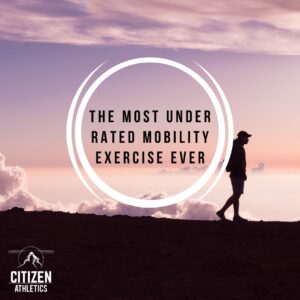Mobility is so hot right now and everyone wants more of it.
If someone asked me what the single best mobility exercise that ever existed is, I’d say that it depends.
Sorry, cliche, I know, but truth. However, that doesn’t mean there aren’t ones that are at the top of the list generally for most people.
For the vast majority of people, doing some supported squatting, down dog variations, world’s greatest stretch, 90/90 w/ thoracic reaches, or other similar movements are great options and bring a lot of bang for your buck, but those kinds of things already get tons of love and people often jump at them.
In contrast, there is one mobility movement that people often neglect, ignore, and do not appreciate just how awesome it can be.
Walking.
Yeah you read that right, walking.
I’d bet most people would get more out of walking an additional 60 seconds than stretching just about anything for 60 seconds when it comes to any kind of mobility – especially in the long run.
Walking has a lot going on that is awesome for driving good adaptations and helping people be mobile.
And before someone asks – no there isn’t a specific way to walk. Are there “wrong” ways, maybe, but not really. I’m sure we can find some extreme examples that aren’t ideal, but there is no such thing as the “right way” to walk.
Firstly, walking can be a very relaxing activity. For most people, relaxing and chilling out can facilitate improved mobility.
Secondly, walking utilizes a good amount of joint range.
When we walk, we take our ankle through a good amount of motion – particularly if we take longer steps.
This gets compounded if you get off the standard pavement and start walking out in nature and are challenged to move through more triplanar motions.
The knee and hip get to cycle into full extension, which are important motions.
A lot of people focus on doing hip extension mobility work, stretching out their hip flexors. Walking is essentially an alternating repeated stretch for the hip flexors.
Walking doesn’t require a lot of hip or knee flexion, but it doesn’t challenge us to control our opposite limb while working through it on one side – which is a valuable trait to still have.
While walking is often viewed as just a lower body activity, we also have motion occur at the trunk and upper body.
Our lower back gets to work through some gentle flexion, extension, rotation, and side flexion as we walk.
This is probably one aspect of why walking has been shown to be an excellent exercise for managing lower back pain.
The thoracic spine and neck have motion occur as well, opposite actions to the lower back to have a net neutral displacement of the trunk.
Even at the shoulder we see walking go through motion.
Generally we have reciprocal actions occur at the shoulder to the hip, meaning if our left leg is flexing, our left arm should be extending.
Most people looking for shoulder mobility drills are trying to find stuff for shoulder flexion, but shoulder extension is actually a really important motion as well.
Walking takes us through shoulder extension repeatedly, much like at the hip. This makes for it as a great low intensity shoulder drill.
How much should you do?
In this article from E3Rehab they outline the research showing that there isn’t really a minimum or maximum amount.
We essentially see that there is a big benefit from doing some, and the benefit gradually diminishes with more – but it’s still there.
For most people, getting in at least 4500 steps per day is ideal. This ensures you’re getting in a good baseline amount for relatively health.
After that, it gets a bit less clear. From my experience for myself and with my athletes, when we have consistently higher step counts per day, we often feel our best.
There is likely compounding aspects from the low level mobility working being good for our joints and muscles, helping get in some calorie burn, and probably the relaxation that comes with walking.
At the end of the day, if you’ve got some spare time on your hands and aren’t getting at a minimum 4500 steps per day, then you’re probably better of walking than stretching. Once we get past that, it’s harder to say, but I’d sway towards walking.


